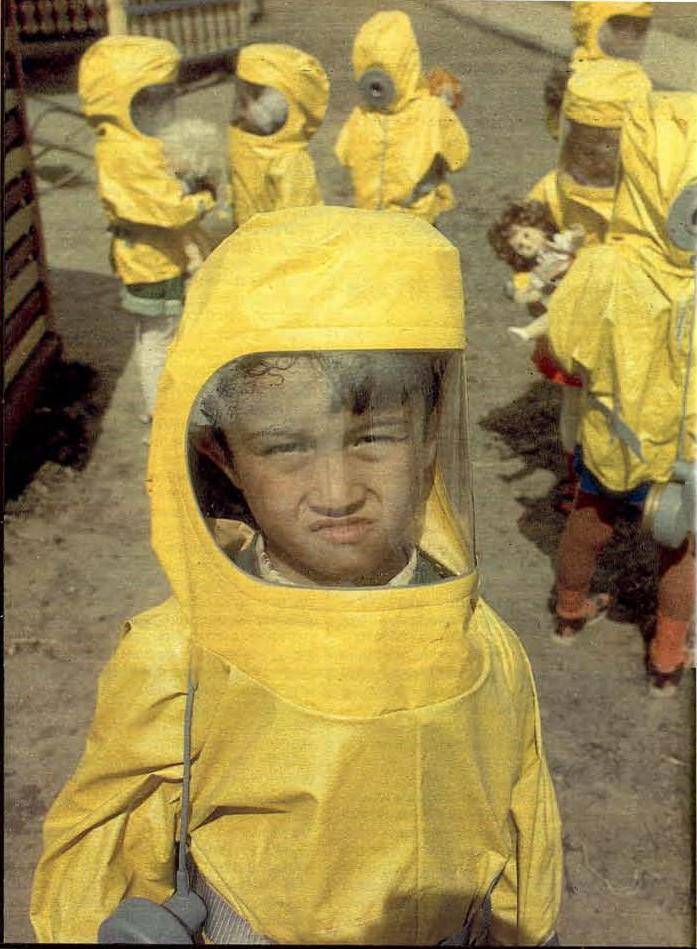
Soviet Economy: Pollution

Figure 1.--This is an example of tghe almost unbelievanle situation in the Soviet Union. The magazine "Smena" (The Replacement) (issue 14 1988) reported on a Soviet town where the pollution was so bad, the children had to wear protective suits to get to school. It ws almost like they were on Venus. It was not a new problem, but only with Glasnost could it bereported in the press. These children attended a kindergarden that was established 6 kilometers (3 miles) from the Aksarai Gas Processing Plant which still exists. The plant converts associated petroleum gas (APG) into plastics, rubber and other raw materials. Wastes from such plants (especially old Soviet-era plants) are very toxic, containing sulfur, carbon-dioxide and other dangerous chemicals. The town is Seitovkain the Astrakhan region. Click on the image to see the plant. Some of the text of the articke is available for Russian readers. | |
Pollution is not exclusive to our modern world, but became apparent as industry expanded in the 19th century. The first fully conceived instances were the London Fog and the need for sewer systems in modern cities. American and the Western European countries first began addressing the problem seriously after World War II wih laws to clean up the air and rivers polluted by indusurial emissions and runoff. For many in tghe West it seemed a problem primarily associated with capitalism. Corporations in an effort to make profits made no effort to limit or control emmissions of pollutants into the air and ikndustrial run off. This became a major concern in the 1960s and 70s. The problem in the West was addressed through a free press and the political and legal system. Voters demanded action frim their elected representatives. And agrieved parties could go into the courtsfor redress. Gradually laws and court cases convinved corportations that it was more cost effective to deal with the pollution problem. We heard nothing about pollution behind the Iron Curtain. Many assummed that because the Soviet Government owned and operated the factories that officials would not permit serious environmental problems to develop. We now know that nothing could be further than the truth. Even without the Western profit system, Soviet policies had created vast environmental problems. The situation in Cental Asia was a major problem, but factory managers throughouut the Soviet Union gave no attention to emissions and industrial runoff. It ws not that these problems did not exist, it was just that the Soviet press was not allowed to report on the problems which would impair the propaganda line of a perfect society. Only with General Secretary Gorbechev's Glasnost policy did we begin to learn about the hitherto hidden problem of pollution in the Soviet Unuon. There were costs to addressing pollution and adressing the problem would impair performance and the achievement of asigned gols and quotas. Soviet managers were awarded for production, not for clean air nd water. The same dynamic was also at play in the Soviet Unions's Eastern European empire which became known only after the fall of Communism.
CIH

Navigate the Children in History Website:
[Return to Main Soviet economy page]
[Return to Main Soviet communism page]
[Return to Main specific war and crisis page]
[About Us]
[Introduction][Biographies][Chronology][Climatology][Clothing][Disease and Health][Economics][Freedom][Geography][History][Human Nature][Ideology][Law]
[Nationalism][Presidents][Religion][Royalty][Science][Social Class]
[Bibliographies][Contributions][FAQs][Glossaries][Images][Links][Registration][Tools]
[Children in History Home]
Created: 9:45 PM 2/4/2013
Last updated: 9:45 PM 2/4/2013



